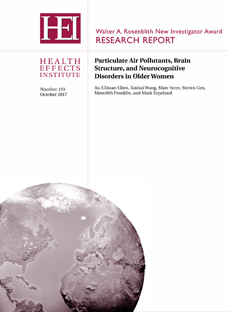You are here
Examining air pollution and neurocognitive effects in older women
 Dementia is relatively common in elderly people. Because there is no cure, there has been much interest in identifying risk factors. Research Report 193, Particulate Air Pollutants, Brain Structure, and Neurocognitive Disorders in Older Women, examines whether air pollution might be involved. Jiu-Chiuan Chen of the University of Southern California, a recipient of HEI’s Walter A. Rosenblith New Investigator Award, and colleagues examined possible associations between long-term exposure to ambient particulate matter (PM) and changes in the brains of older women, focusing on neurocognitive outcomes (mild cognitive impairment and dementia) and brain volumes. Dr. Chen used data from almost 7,500 women, ages 65–80, enrolled in the U.S.-based Women’s Health Initiative Memory Study. To estimate the women’s exposure to particles, they used two PM exposure metrics: ambient PM2.5 at the residential address (using a nationwide spatiotemporal model based on central monitoring data) and on-road diesel PM at the census-tract level (based on data from the National-Scale Air Toxics Assessment). For further information, see HEI Update, Spring 2017.
Dementia is relatively common in elderly people. Because there is no cure, there has been much interest in identifying risk factors. Research Report 193, Particulate Air Pollutants, Brain Structure, and Neurocognitive Disorders in Older Women, examines whether air pollution might be involved. Jiu-Chiuan Chen of the University of Southern California, a recipient of HEI’s Walter A. Rosenblith New Investigator Award, and colleagues examined possible associations between long-term exposure to ambient particulate matter (PM) and changes in the brains of older women, focusing on neurocognitive outcomes (mild cognitive impairment and dementia) and brain volumes. Dr. Chen used data from almost 7,500 women, ages 65–80, enrolled in the U.S.-based Women’s Health Initiative Memory Study. To estimate the women’s exposure to particles, they used two PM exposure metrics: ambient PM2.5 at the residential address (using a nationwide spatiotemporal model based on central monitoring data) and on-road diesel PM at the census-tract level (based on data from the National-Scale Air Toxics Assessment). For further information, see HEI Update, Spring 2017.


